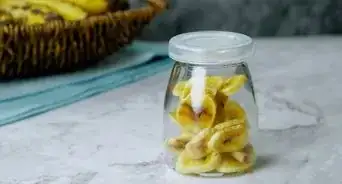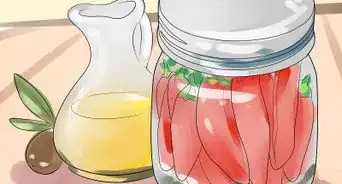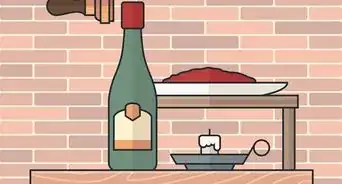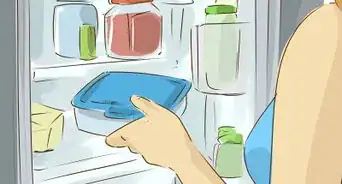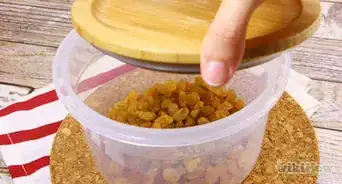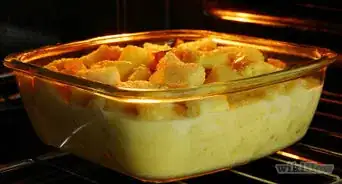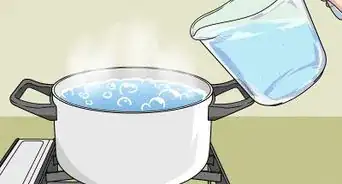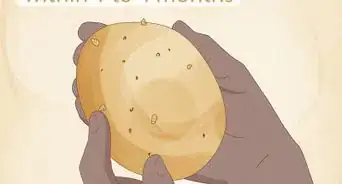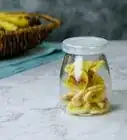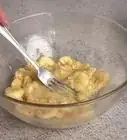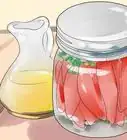wikiHow is a “wiki,” similar to Wikipedia, which means that many of our articles are co-written by multiple authors. To create this article, 20 people, some anonymous, worked to edit and improve it over time.
There are 7 references cited in this article, which can be found at the bottom of the page.
The wikiHow Culinary Team also followed the article's instructions and verified that they work.
This article has been viewed 443,706 times.
Learn more...
Dehydrating bananas is a surprisingly easy and versatile process. Sticky or crispy, healthy or greasy, chips, wedges, or fruit leather — you can make all kinds of snacks using just about any heat source available. It might not be possible to get tired of this flavor, but just in case there are instructions for adding sweet or savory spices as well.
Ingredients
- Bananas (ideally just ripe, with a few brown speckles but no large spots or bruises)
- Lemon juice or another acidic juice (optional)
- Salt, nutmeg, or cinnamon for taste (optional)
Steps
Chips or Wedges in an Oven
-
1Preheat your oven to the lowest temperature setting. This is usually between 125º—200ºF (50º—90ºC).
- A higher temperature risks scorching the outside and not drying the inside.
-
2Peel and slice the bananas. To make chips, slice the bananas into 1/4 inch (0.6 cm) rounds. To make wedges, cut the banana lengthwise, then lengthwise again, and slice into desired length.[1]
- NOTE: Wedges can take up to 12 hours to dry! Start preparing them in the morning so you don't risk starting a fire overnight. Chips dry much more quickly.
- For extra crispy chips, slice the bananas into 1/8 inch rounds instead (0.3 cm). This may be easier with a mandoline.
- If the bananas are mushy and difficult to slice, chill them in the fridge for 5-10 minutes to firm them up.[2]
- You don't even need a knife to make wedges! Work your finger into the end of the peeled banana and it should divide into three segments.[3] It doesn't matter if the banana breaks in the process. You'll want it in smaller lengths anyway.
- For a large quantity of bananas, soaking them in lemon juice for several minutes before slicing will save you preparation time, but the additional moisture will add time to the baking stage.[4]
Advertisement -
3Dip the pieces in lemon juice. This will add flavor and vitamins, but the main purpose is to prevent the bananas from turning brown.
- If you don't mind brown chips, you can skip this step.
- Brushing the juice onto both sides of the bananas will also work.
- Pineapple juice, lime juice, or any other acidic juice will work instead. You can even use vitamin C tablets crushed in water.
- If you don't like the flavor of the juice, dilute it in a 1:4 ratio with water and soak the bananas for 3-5 minutes.
-
4Place the bananas on a wire rack. This raised wire platform exposes every side of the banana to the air and allows excess moisture to drip through. Also ready a cookie sheet or baking pan to place beneath it.
- The bananas should be in a single layer, not stacked atop each other. It's fine if their edges are touching.
- If you don't have a wire rack, cover a cookie sheet with parchment paper or spray it with a nonstick cooking spray. This method will be less effective at removing moisture and could take many hours longer (especially for wedges). You can mitigate this by leaving the oven door a few inches ajar to allow moisture to escape.[5]
- An electric fan kept next to the open oven door will also help air circulate.[6]
-
5Add additional flavor if desired. A sprinkling of sea salt or kosher salt adds a great savory flavor, perfect for eating on their own.
-
6Place the bananas in the preheated oven. Use the center rack of the oven and be careful not to drop any slices onto the oven floor.
- If using a wire rack, place the baking sheet in the oven first to catch drips, then place the rack on top of the baking sheet.
-
7Let them bake according to shape and desired crispiness. For chips, this will take 1 to 3 hours. Wedges will take 6 to 12 hours. The longer you bake them, the crispier they will be.
- Flip the bananas over once about halfway through the baking process. This will dry each side evenly and is especially important if the bananas are placed directly on a baking sheet.
- The bananas will become crispier as they cool, so remove them when they're still a little softer than you would like.
-
8Cool the bananas completely on a wire rack. They won't be completely dry or crunchy until they're cooled to room temperature.
- If you don't have a wire rack, a dish-drying rack can work instead. An ordinary plate will still do in a pinch.
-
9Store the bananas in an airtight container. If completely dried, they should stay good for months.
Chips or Chews in a Dehydrator
-
1Prepare the bananas. The early preparation is similar to the oven method, but pay attention to the sizes.
- Peel the bananas and slice them in 1/4 inch rounds (0.6 cm) to produce leathery chews, or slice them 1/16 to 1/8 inches thick (0.15 to 0.3 cm) to make crunchy chips.
- Chips will take up to 24 hours to dehydrate, whereas leather should be done within 12. Plan accordingly.
- Slices smaller than 1/4 inch (0.6 cm) will tend to stick together when stored.
- Dip the pieces in lemon juice to prevent the chips from turning brown. This step is optional.
-
2Add additional flavor if desired. Grated nutmeg works well with the bananas' natural sweetness.[7]
-
3Spray or rub a little oil on the rack of your dehydrator. This step isn't mandatory but will prevent the banana slices from sticking. You could even rub oil directly onto the bananas to be extra cautious.
-
4Place the slices on the dehydrator's drying rack. None of the slices should overlap. It's fine if they touch slightly; they should shrink a little as they dry.
-
5Set the temperature to 135º F (57ºC). Making leathery chews will take anywhere from 6 to 12 hours. Crisp chips will take longer, up to a full 24 hour day.
- If your model of dehydrator comes with specific instructions for bananas, use the temperature and time listed there instead.
- Check their progress every 2-4 hours and rotate the tray to ensure even drying.
- If you decided not to put lemon juice on them, the caramel brown color is a good sign that they're done or nearly done. Otherwise, you can take a sample out to taste test once it's cooled to room temperature.
- If you leave your chews in too long and dislike the extra-tough texture, continue to dehydrate them and turn them into crisps. This may not work if the slices are extra thick.
-
6Cool the bananas to room temperature before eating. If you store them in an airtight container, they should stay good for months.
Fruit Leather in a Dehydrator
-
1Peel the bananas. You can keep them whole or slice them in half lengthwise.
-
2Place the whole bananas between two sheets of parchment paper. The bananas should be at least 3 inches apart from one another.
-
3Use a heavy cutting board to smash the bananas. Try to apply even pressure to keep the banana mash an even consistency.
- You can also use a rolling pin for this.
- The goal is to get the bananas down to about 1/8 of an inch (0.3 cm). If you don't want to measure them, just make it as flat as you can!
-
4Transfer the parchment paper to the dehydrator rack. Peel off the top sheet before you begin dehydrating.
-
5Set your dehydrator to 135ºF (57ºC) for 7 hours. Check in at the 4 and 6-hour mark to see how they're doing.
- When ready, the top should be leathery but not sticky.
- If the bottom is still moist, you can optionally flip them over halfway through.
-
6Let cool and slice into strips. These can be rolled up and stored in an airtight container for several months.
Microwave Crisps
-
1Peel and slice the bananas. Aim for 1/4 inch rounds (0.6 cm) or slightly smaller. Larger slices won't cook as well, while smaller ones burn more easily.
-
2Oil a microwave-safe plate.[8] Use a generous amount of pleasantly flavored oil such as olive or coconut oil. Place the banana slices on the plate with space between each one.
-
3Microwave on high for one minute. The bananas should start turning soft and releasing moisture.
-
4Turn each slice over. You can also add additional flavor at this point. A sprinkling of sea salt or kosher salt adds a great savory flavor, while grated nutmeg or ground cinnamon works well with the bananas' sweetness.[9]
-
5Continue microwaving for 30 seconds at a time. This might take a couple of minutes depending on your microwave.
-
6Serve immediately. Unlike other drying methods, these will only stay fresh for about a day.
Sun-Drying Chips
-
1Check your area's weather forecast. To successfully sun dry fruit, you'll need at least 2 days of hot, dry weather and a clear sky (at least 90º F/32ºC with low humidity). Ideally, you should allow for a full 7 days of drying, especially if the temperature is below 100ºF/38ºC.
-
2Make or purchase an outdoor drying screen. All you need is a rectangular wooden frame with a food-safe mesh stretched across it.
- Stainless steel or plastic are the best options for meshes. Do NOT use aluminum, hardware cloth, or fiberglass meshes (unless the fiberglass mesh is clearly labeled food-grade).
-
3Prepare the bananas. Since you're using a much lower temperature than other methods, you may wish to slice them extra thin.
- Peel the bananas and slice them into 1/8 inch rounds (0.3 cm), or at least no larger than 1/4 inch (0.6 cm).
- If you want to prevent browning, dip the pieces in lemon juice.
-
4Add additional flavor if desired. Powdered cinnamon adds a strong flavor for sweet snacking.
-
5Place the chips on the mesh of the drying frame. Keep them in a single layer with no overlaps. It's fine if their edges touch; they should shrink a little as they dry.
-
6Cover the chips with an insect-proof netting or cheesecloth. This will help keep dust off your food as well.
-
7Place the drying frame in direct sunlight away from sources of car exhaust and out of reach of animals. Elevate it at least a few inches off the ground (for instance by placing it atop stacked cinder blocks).
- Your roof is a great high-sun option that keeps it removed from most environmental pollution.
- A concrete driveway will reflect the heat from the ground, drying the bananas faster.
-
8Bring the drying frame indoors at night. Even if the nights are still relatively warm, dew will add additional moisture to the bananas. Put it outside again during the day.
-
9Flip the bananas over once about halfway through the drying process. The timing doesn't need to be precise; anytime on the second day of drying is fine.
-
10Continue to dry for up to 7 days. Check daily to see if they're ready to eat.
- If you're not sure, just cut one open or bite into it to check for moisture.
-
11Store the bananas in an airtight container. If completely dried, they should stay good for months.
-
12Finished.
Community Q&A
-
QuestionCan banana chips be dried unpeeled? Can drying process begin in microwave then finished in air fryer?
 wikiHow Staff EditorThis answer was written by one of our trained team of researchers who validated it for accuracy and comprehensiveness.
wikiHow Staff EditorThis answer was written by one of our trained team of researchers who validated it for accuracy and comprehensiveness.
Staff Answer wikiHow Staff EditorStaff AnswerBanana chips can be dried unpeeled. Note that it will take longer to dry them like this because the peel is thicker and will likely retain more moisture. It's also possible that unpeeled banana chips may not turn out as crispy as peeled ones. To answer your next question, yes, you can start the drying process in a microwave and then finish it in an air fryer. However, be aware this would depend on the specific recipe or instructions you're using. Since the microwave is not typically used to dry fruits, it is best used to partly pre-cook the banana chips before finishing them in a dehydrator or air fryer. Using both the microwave and air fryer in combination could cause uneven drying. Try consulting a recipe or guide specifically designed for this method. In general, it is recommended to use a dehydrator, oven or air fryer specifically designed for dehydrating fruits because they have low temperatures and a fan which helps with precise control and ensures even drying of the fruits and less chances of over-cooking them.
wikiHow Staff EditorStaff AnswerBanana chips can be dried unpeeled. Note that it will take longer to dry them like this because the peel is thicker and will likely retain more moisture. It's also possible that unpeeled banana chips may not turn out as crispy as peeled ones. To answer your next question, yes, you can start the drying process in a microwave and then finish it in an air fryer. However, be aware this would depend on the specific recipe or instructions you're using. Since the microwave is not typically used to dry fruits, it is best used to partly pre-cook the banana chips before finishing them in a dehydrator or air fryer. Using both the microwave and air fryer in combination could cause uneven drying. Try consulting a recipe or guide specifically designed for this method. In general, it is recommended to use a dehydrator, oven or air fryer specifically designed for dehydrating fruits because they have low temperatures and a fan which helps with precise control and ensures even drying of the fruits and less chances of over-cooking them. -
QuestionCan I use lime juice?
 Community AnswerYou sure can, any juice with a high amount of vitamin C will work. You could even crush up some vitamin C tablets and mix those with water.
Community AnswerYou sure can, any juice with a high amount of vitamin C will work. You could even crush up some vitamin C tablets and mix those with water. -
QuestionCan I use apple cider vinegar instead of lemon juice?
 Community AnswerYes, but it might affect the final taste of the dehydrated bananas.
Community AnswerYes, but it might affect the final taste of the dehydrated bananas.
Warnings
- Using the wrong type of mesh in your drying rack or a wire rack not intended for cooking can cause discoloration, bad flavor, or even dangerous material in your bananas. Follow the instructions carefully when selecting a mesh, and only use wire racks intended for food preparation.⧼thumbs_response⧽
Things You'll Need
-
One of the following:
- Microwave
- Oven & Baking Sheet
- Dehydrator (plus parchment paper for fruit leather)
- Drying Frame, Netting, and a Hot Sunny Week
- Knife
- Cutting Board
- Wire Rack
- Mandoline (optional)
References
- ↑ http://www.storyofakitchen.com/healthy-snacks/dried-bananas/
- ↑ http://www.easy-food-dehydrating.com/dehydrating-bananas.html
- ↑ http://foodstorageandsurvival.com/making-banana-chips-by-dehydrating-bananas/
- ↑ http://www.aces.uiuc.edu/vista/html_pubs/DRYING/dryfood.html
- ↑ http://www.storyofakitchen.com/healthy-snacks/dried-bananas/
- ↑ http://www.aces.uiuc.edu/vista/html_pubs/DRYING/dryfood.html#methods
- ↑ http://www.foodiewithfamily.com/2012/03/23/nutmeg-banana-chips/
- ↑ http://www.cookingandme.com/2014/05/microwave-banana-chips-healthy-raw.html
- ↑ http://www.foodiewithfamily.com/2012/03/23/nutmeg-banana-chips/
About This Article
To dehydrate bananas, start by peeling and slicing the bananas into chips or wedges. Then, dip the bananas in lemon juice, which will stop them from turning brown. To dehydrate the bananas in the oven, spread them out on one of the racks and bake them at 200 degrees Fahrenheit for 3-12 hours, depending on how crispy you want them. If you're using a dehydrator, spread them out on the rack and dry them for 12-24 hours at 135 degrees Fahrenheit. To learn how to make banana crisps in the microwave, scroll down!
